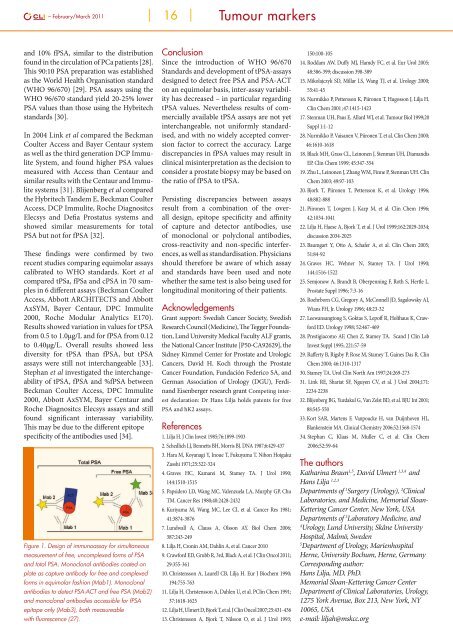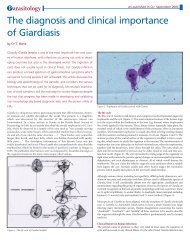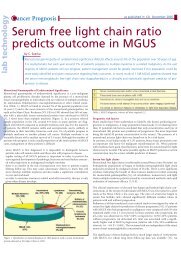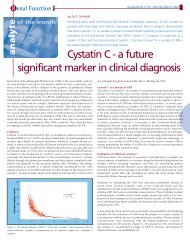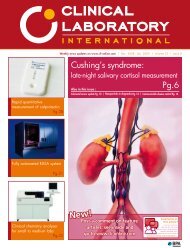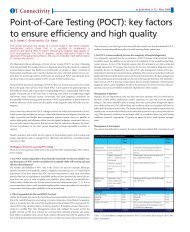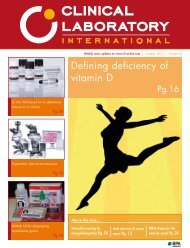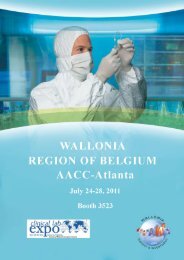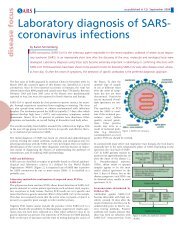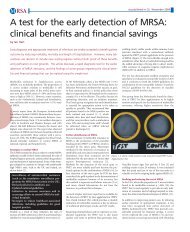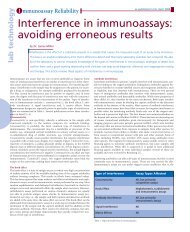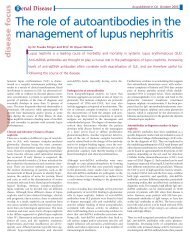Screening for cancer: are biomarkers of value?
Screening for cancer: are biomarkers of value?
Screening for cancer: are biomarkers of value?
You also want an ePaper? Increase the reach of your titles
YUMPU automatically turns print PDFs into web optimized ePapers that Google loves.
– February/March 2011 16 Tumour markers<br />
and 10% fPSA, similar to the distribution<br />
found in the circulation <strong>of</strong> PCa patients [28].<br />
This 90:10 PSA preparation was established<br />
as the World Health Organisation standard<br />
(WHO 96/670) [29]. PSA assays using the<br />
WHO 96/670 standard yield 20-25% lower<br />
PSA <strong>value</strong>s than those using the Hybritech<br />
standards [30].<br />
In 2004 Link et al comp<strong>are</strong>d the Beckman<br />
Coulter Access and Bayer Centaur system<br />
as well as the third generation DCP Immulite<br />
System, and found higher PSA <strong>value</strong>s<br />
measured with Access than Centaur and<br />
similar results with the Centaur and Immulite<br />
systems [31]. Blijenberg et al comp<strong>are</strong>d<br />
the Hybritech Tandem E, Beckman Coulter<br />
Access, DCP Immulite, Roche Diagnositcs<br />
Elecsys and Defia Prostatus systems and<br />
showed similar measurements <strong>for</strong> total<br />
PSA but not <strong>for</strong> fPSA [32].<br />
These findings were confirmed by two<br />
recent studies comparing equimolar assays<br />
calibrated to WHO standards. Kort et al<br />
comp<strong>are</strong>d tPSa, fPSa and cPSA in 70 samples<br />
in 6 different assays (Beckman Coulter<br />
Access, Abbott ARCHITECTS and Abbott<br />
AxSYM, Bayer Centaur, DPC Immulite<br />
2000, Roche Modular Analytics E170).<br />
Results showed variation in <strong>value</strong>s <strong>for</strong> tPSA<br />
from 0.5 to 1.0µg/L and <strong>for</strong> fPSA from 0.12<br />
to 0.40µg/L. Overall results showed less<br />
diversity <strong>for</strong> tPSA than fPSA, but tPSA<br />
assays were still not interchangeable [33].<br />
Stephan et al investigated the interchangeability<br />
<strong>of</strong> tPSA, fPSA and %fPSA between<br />
Beckman Coulter Access, DPC Immulite<br />
2000, Abbott AxSYM, Bayer Centaur and<br />
Roche Diagnositcs Elecsys assays and still<br />
found significant interassay variability.<br />
This may be due to the different epitope<br />
specificity <strong>of</strong> the antibodies used [34].<br />
Figure 1. Design <strong>of</strong> immunoassay <strong>for</strong> simultaneous<br />
measurement <strong>of</strong> free, uncomplexed <strong>for</strong>ms <strong>of</strong> PSA<br />
and total PSA. Monoclonal antibodies coated on<br />
plate as capture antibody <strong>for</strong> free and complexed<br />
<strong>for</strong>ms in equimolar fashion (Mab1). Monoclonal<br />
antibodies to detect PSA-ACT and free PSA (Mab2)<br />
and monoclonal antibodies accessible <strong>for</strong> fPSA<br />
epitope only (Mab3), both measureable<br />
with fluorescence (27).<br />
Conclusion<br />
Since the introduction <strong>of</strong> WHO 96/670<br />
Standards and development <strong>of</strong> tPSA-assays<br />
designed to detect free PSA and PSA-ACT<br />
on an equimolar basis, inter-assay variability<br />
has decreased – in particular regarding<br />
tPSA <strong>value</strong>s. Nevertheless results <strong>of</strong> commercially<br />
available tPSA assays <strong>are</strong> not yet<br />
interchangeable, not uni<strong>for</strong>mly standardised,<br />
and with no widely accepted conversion<br />
factor to correct the accuracy. Large<br />
discrepancies in fPSA <strong>value</strong>s may result in<br />
clinical misinterpretation as the decision to<br />
consider a prostate biopsy may be based on<br />
the ratio <strong>of</strong> fPSA to tPSA.<br />
Persisting discrepancies between assays<br />
result from a combination <strong>of</strong> the overall<br />
design, epitope specificity and affinity<br />
<strong>of</strong> capture and detector antibodies, use<br />
<strong>of</strong> monoclonal or polyclonal antibodies,<br />
cross-reactivity and non-specific interferences,<br />
as well as standardisation. Physicians<br />
should there<strong>for</strong>e be aw<strong>are</strong> <strong>of</strong> which assay<br />
and standards have been used and note<br />
whether the same test is also being used <strong>for</strong><br />
longitudinal monitoring <strong>of</strong> their patients.<br />
Acknowledgements<br />
Grant support: Swedish Cancer Society, Swedish<br />
Research Council (Medicine), The Tegger Foundation,<br />
Lund University Medical Faculty ALF grants,<br />
the National Cancer Institute [P50-CA92629], the<br />
Sidney Kimmel Center <strong>for</strong> Prostate and Urologic<br />
Cancers, David H. Koch through the Prostate<br />
Cancer Foundation, Fundación Federico SA, and<br />
German Association <strong>of</strong> Urology (DGU), Ferdinand<br />
Eisenberger research grant Competing interest<br />
declaration: Dr Hans Lilja holds patents <strong>for</strong> free<br />
PSA and hK2 assays.<br />
References<br />
1. Lilja H. J Clin Invest 1985;76:1899-1903<br />
2. Schedlich LJ, Bennetts BH, Morris BJ. DNA 1987;6:429-437<br />
3. Hara M, Koyanagi Y, Inoue T, Fukuyama T. Nihon Hoigaku<br />
Zasshi 1971;25:322-324<br />
4. Graves HC, Kam<strong>are</strong>i M, Stamey TA. J Urol 1990;<br />
144:1510-1515<br />
5. Papsidero LD, Wang MC, Valenzuela LA, Murphy GP, Chu<br />
TM. Cancer Res 1980;40:2428-2432<br />
6. Kuriyama M, Wang MC, Lee CI, et al. Cancer Res 1981;<br />
41:3874-3876<br />
7. Lundwall A, Clauss A, Olsson AY. Biol Chem 2006;<br />
387:243-249<br />
8. Lilja H, Cronin AM, Dahlin A, et al. Cancer 2010<br />
9. Craw<strong>for</strong>d ED, Grubb R, 3rd, Black A, et al. J Clin Oncol 2011;<br />
29:355-361<br />
10. Christensson A, Laurell CB, Lilja H. Eur J Biochem 1990;<br />
194:755-763<br />
11. Lilja H, Christensson A, Dahlen U, et al. PClin Chem 1991;<br />
37:1618-1625<br />
12. Lilja H, Ulmert D, Bjork T, et al. J Clin Oncol 2007;25:431-436<br />
13. Christensson A, Bjork T, Nilsson O, et al. J Urol 1993;<br />
150:100-105<br />
14. Roddam AW, Duffy MJ, Hamdy FC, et al. Eur Urol 2005;<br />
48:386-399; discussion 398-389<br />
15. Mikolajczyk SD, Millar LS, Wang TJ, et al. Urology 2000;<br />
55:41-45<br />
16. Nurmikko P, Pettersson K, Piironen T, Hugosson J, Lilja H.<br />
Clin Chem 2001 ;47:1415-1423<br />
17. Stenman UH, Paus E, Allard WJ, et al. Tumour Biol 1999;20<br />
Suppl 1:1-12<br />
28. Nurmikko P, Vaisanen V, Piironen T, et al. Clin Chem 2000;<br />
46:1610-1618<br />
18. Black MH, Grass CL, Leinonen J, Stenman UH, Diamandis<br />
EP. Clin Chem 1999; 45:347-354<br />
19. Zhu L, Leinonen J, Zhang WM, Finne P, Stenman UH. Clin<br />
Chem 2003; 49:97-103<br />
20. Bjork T, Piironen T, Pettersson K, et al. Urology 1996;<br />
48:882-888<br />
21. Piironen T, Lovgren J, Karp M, et al. Clin Chem 1996;<br />
42:1034-1041<br />
22. Lilja H, Haese A, Bjork T, et al. J Urol 1999;162:2029-2034;<br />
discussion 2034-2025<br />
23. Baumgart Y, Otto A, Schafer A, et al. Clin Chem 2005;<br />
51:84-92<br />
24. Graves HC, Wehner N, Stamey TA. J Urol 1990;<br />
144:1516-1522<br />
25. Semjonow A, Brandt B, Oberpenning F, Roth S, Hertle L.<br />
Prostate Suppl 1996; 7:3-16<br />
26. Roehrborn CG, Gregory A, McConnell JD, Sagalowsky AI,<br />
Wians FH, Jr. Urology 1996; 48:23-32<br />
27. Leewansangtong S, Goktas S, Lep<strong>of</strong>f R, Holthaus K, Craw<strong>for</strong>d<br />
ED. Urology 1998; 52:467-469<br />
28. Prestigiacomo AF, Chen Z, Stamey TA. Scand J Clin Lab<br />
Invest Suppl 1995; 221:57-59<br />
29. Rafferty B, Rigsby P, Rose M, Stamey T, Gaines Das R. Clin<br />
Chem 2000; 46:1310-1317<br />
30. Stamey TA. Urol Clin North Am 1997;24:269-273<br />
31.Link RE, Shariat SF, Nguyen CV, et al. J Urol 2004;171:<br />
2234-2238<br />
32. Blijenberg BG, Yurdakul G, Van Zelst BD, et al. BJU Int 2001;<br />
88:545-550<br />
33. Kort SAR, Martens F, Vanpoucke H, van Duijnhoven HL,<br />
Blankenstein MA. Clinical Chemistry 2006;52:1568-1574<br />
34. Stephan C, Klaas M, Muller C, et al. Clin Chem<br />
2006;52:59-64<br />
The authors<br />
Katharina Braun 1,5 , David Ulmert 1,3,4 and<br />
Hans Lilja 1,2,3<br />
Departments <strong>of</strong> 1 Surgery (Urology), 2 Clinical<br />
Laboratories, and Medicine, Memorial Sloan-<br />
Kettering Cancer Center, New York, USA<br />
Departments <strong>of</strong> 3 Laboratory Medicine, and<br />
4<br />
Urology, Lund University, Skåne University<br />
Hospital, Malmö, Sweden<br />
5<br />
Department <strong>of</strong> Urology, Marienhospital<br />
Herne, University Bochum, Herne, Germany<br />
Corresponding author:<br />
Hans Lilja, MD, PhD.<br />
Memorial Sloan-Kettering Cancer Center<br />
Department <strong>of</strong> Clinical Laboratories, Urology,<br />
1275 York Avenue, Box 213, New York, NY<br />
10065, USA<br />
e-mail: liljah@mskcc.org


